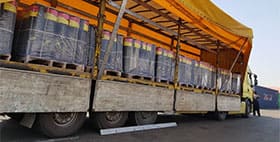Handling Details
Handling Details
- Home
- Water Proofing
- Waterproofing Products
- Bitumen Membrane
- Implementation of Bituminous Membrane
- Handling Details
Transport

The pallets are covered with a sheet of very thick heat-shrink polythene, but long journeys on uneven roads and sharp braking can cause the rolls to tip up. This problem can be avoided by running ropes through the rows of pallets, crosswise to the width of the bed of the lorry. The ropes must be properly tightened and suitably protected so that they do not leave marks on the rolls.
Loading/Unloading

The material should be stored undercover. The rolls whether covered or uncovered must remain in a vertical position on a smooth, flat surface, except for those provided with a rigid core or tube, which can tolerate a horizontal position for a limited time. Undercover, the panels can be stacked in two layers with lengths of timber between the layers to spread the weight. Rolls of Thermo base are stored upright in the same way as the membranes, with the exception of rolls with a selvage which should be arranged horizontally.
Storage

The material should be stored under cover. The rolls whether covered or uncovered must remain in a vertical position on a smooth, flat surface, except for those provided with a rigid core or tube, which can tolerate a horizontal position for a limited time. Under cover, the panels can be stacked in two layers with lengths of timber between the layers to spread the weight. Rolls of Thermobase are stored upright in the same way as the membranes, with the exception of rolls with a selvedge which should be arranged horizontally.
On-Site Handling

Keep on-site only the rolls strictly necessary for laying during the day. Set the rolls upright on a smooth, flat surface. Use a crane to lift the rolls onto the roof, keeping the pallet complete and intact and using suitable lifting gear. If the packs have to be opened and the rolls lifted loose, use suitable lifting gear with the crane and in any event set the rolls upright after lifting. Do not use ropes to tie and lift the rolls.
Conservation

It should also be borne in mind that exposure to heat, as is well known, causes progressive and predictable loss of flexibility, but if what happens naturally in use happens instead to material still on the roll, it is possible that cracking problems or difficulty unrolling the material may occur.
In winter the rolls should be stored for 24 hours at a temperature above +5°C before laying. Avoid leaving the rolls in the open overnight. Only the rolls which will be applied during the day should be brought onto the site. A good rule is always to “rotate” the stock and not to keep rolls for more than 12 months.